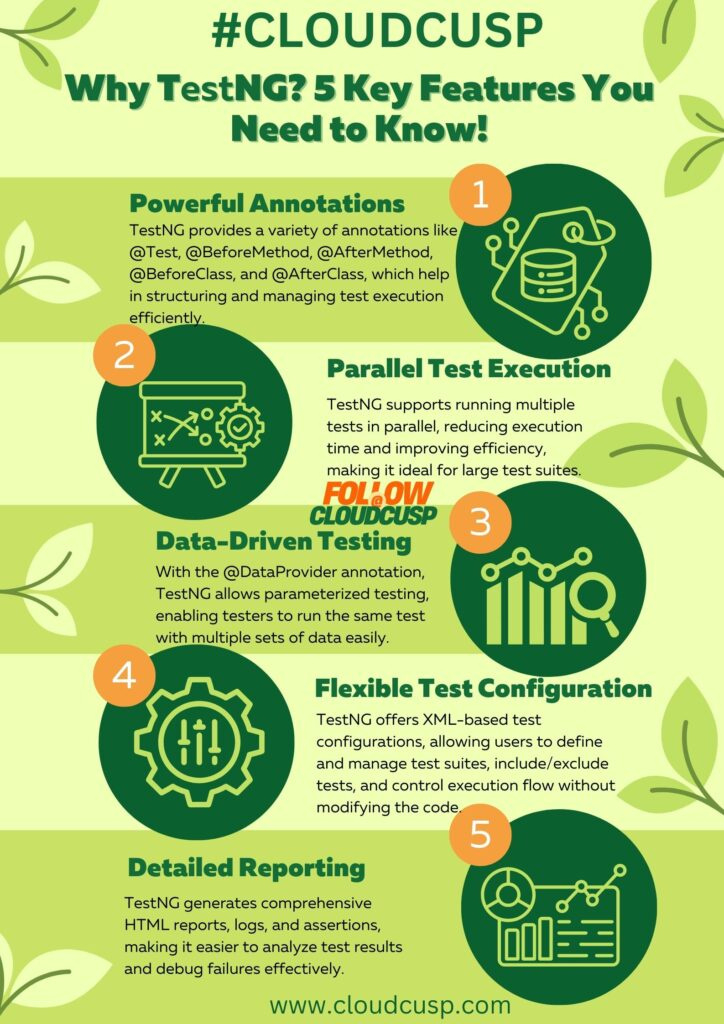Unit testing is the heartbeat of reliable software development. It ensures that individual components of your code work as expected, catching bugs before they snowball into bigger problems. For Java developers, two frameworks stand out in the crowded world of testing tools: JUnit and TestNG. These powerhouses have shaped how we validate code, but they aren’t identical twins—each brings its own flavor to the table. JUnit vs TestNG has been a long-standing debate among developers, as both frameworks offer distinct features, strengths, and ideal use cases.
JUnit, the veteran, is celebrated for its simplicity and widespread use, while TestNG, a younger contender inspired by JUnit, flexes its muscles with advanced features for complex testing needs. Whether you’re a beginner writing your first test or a seasoned developer managing sprawling test suites, choosing the right framework can make or break your workflow. In this article, we’ll unpack the differences, strengths, and quirks of JUnit and TestNG to help you decide which one deserves a spot in your toolkit.
On This Page
Table of Contents
1. Overview of JUnit and TestNG
JUnit: The Classic Workhorse
JUnit hit the scene in 1997, co-created by Erich Gamma and Kent Beck, and quickly became the go-to for Java unit testing. It’s lightweight, focused on testing individual units of code—like methods or classes—and integrates seamlessly with tools like Maven and Eclipse. Over the years, it’s evolved, with JUnit 5 (released in 2017) bringing modern features like nested tests and better assertions.
TestNG: The Next-Generation Challenger
TestNG, introduced in 2004 by Cédric Beust, took inspiration from JUnit but aimed higher. Short for “Test Next Generation,” it’s designed not just for unit testing but also for integration and end-to-end tests. It boasts advanced capabilities like parallel execution and test grouping, making it a favorite for larger projects.
Why They Matter
Both frameworks are staples in the Java ecosystem, but their philosophies differ. JUnit keeps things simple and unit-focused, while TestNG embraces flexibility for broader testing scenarios. Let’s dive deeper.
2. Junit vs TestNG: Core Features Comparison
Annotations
Annotations are the backbone of both frameworks, dictating how tests run. Here’s a quick comparison:
| Feature | JUnit 5 | TestNG |
|---|---|---|
| Basic Test Annotation | @Test | @Test |
| Setup Before Test | @BeforeEach | @BeforeMethod |
| Teardown After Test | @AfterEach | @AfterMethod |
| Suite Setup | @BeforeAll (static method) | @BeforeSuite |
- JUnit Example:
import org.junit.jupiter.api.BeforeEach;
import org.junit.jupiter.api.Test;
import static org.junit.jupiter.api.Assertions.assertEquals;
public class CalculatorTest {
private Calculator calc;
@BeforeEach
void setUp() {
calc = new Calculator();
}
@Test
void testAdd() {
assertEquals(5, calc.add(2, 3));
}
}- TestNG Example:
import org.testng.annotations.BeforeMethod;
import org.testng.annotations.Test;
import static org.testng.Assert.assertEquals;
public class CalculatorTest {
private Calculator calc;
@BeforeMethod
void setUp() {
calc = new Calculator();
}
@Test
void testAdd() {
assertEquals(calc.add(2, 3), 5);
}
}Assertions
Both offer robust assertion libraries, but JUnit 5’s Assertions class is more polished, with methods like assertThrows for exception testing. TestNG sticks to a simpler Assert class but compensates with features like soft assertions (which don’t halt execution on failure).
3. Ease of Use and Learning Curve
JUnit: Beginner’s Best Friend
JUnit shines for its straightforwardness. Its minimal setup—just add a dependency to your pom.xml—and intuitive annotations make it ideal for newcomers.
- Maven Dependency:
<dependency>
<groupId>org.junit.jupiter</groupId>
<artifactId>junit-jupiter</artifactId>
<version>5.10.0</version>
<scope>test</scope>
</dependency>TestNG: A Slight Climb
TestNG has a steeper learning curve due to its extensive feature set. Its XML configuration files for test suites can feel overwhelming at first.
- Maven Dependency:
<dependency>
<groupId>org.testng</groupId>
<artifactId>testng</artifactId>
<version>7.8.0</version>
<scope>test</scope>
</dependency>Verdict
If you’re new to testing, JUnit gets you up and running faster. For those comfortable with Java, TestNG’s extras are worth the effort.
4. Flexibility and Advanced Testing Capabilities
Parameterized Tests
Both frameworks support parameterized tests, but their approaches differ:
- JUnit: Uses
@ParameterizedTestwith sources like@ValueSource.
@ParameterizedTest
@ValueSource(ints = {1, 2, 3})
void testPositiveNumbers(int number) {
assertTrue(number > 0);
}- TestNG: Uses
@DataProviderfor more flexibility.
@DataProvider(name = "numbers")
public Object[][] provideNumbers() {
return new Object[][]{{1}, {2}, {3}};
}
@Test(dataProvider = "numbers")
public void testPositiveNumbers(int number) {
assertTrue(number > 0);
}Parallel Execution
- JUnit: Limited parallel support in JUnit 5, requiring external tools like Maven Surefire.
- TestNG: Built-in parallel execution via
testng.xml.
<suite name="ParallelSuite" parallel="methods" thread-count="4">
<test name="Test1">
<classes>
<class name="com.example.TestClass"/>
</classes>
</test>
</suite>Test Grouping
TestNG excels here with its @Test(groups = "groupName") feature, letting you run specific test sets. JUnit lacks native grouping but compensates with tags (@Tag).
5. Community Support and Ecosystem
JUnit: The Crowd Favorite
- Massive community, extensive docs at junit.org.
- Seamless integration with IntelliJ, Eclipse, and Jenkins.
TestNG: The Niche Powerhouse
- Smaller but dedicated community, docs at testng.org.
- Strong support for tools like Selenium and Spring.
Ecosystem Edge
JUnit wins for its ubiquity, but TestNG holds its own in specialized circles.
6. Performance and Scalability
Small Projects
For a handful of tests, both frameworks perform similarly—execution time is negligible.
Large Test Suites
- JUnit: Scales well but can lag without parallelization hacks.
- TestNG: Shines with built-in parallelism, reducing runtime on big projects.
Example Scenario
Running 1000 tests:
- JUnit (sequential): ~20 seconds.
- TestNG (4 threads): ~6 seconds.
7. Use Cases: When to Choose JUnit vs TestNG?
JUnit Sweet Spots
- Small projects or simple unit tests.
- Teams prioritizing simplicity over advanced features.
- Example: Testing a basic
Calculatorclass.
TestNG Sweet Spots
- Complex projects with integration or end-to-end tests.
- Scenarios needing parallel runs or data-driven tests.
- Example: Testing a web app with Selenium.
8. Pros and Cons of JUnit vs TestNG
| Aspect | JUnit Pros | JUnit Cons | TestNG Pros | TestNG Cons |
|---|---|---|---|---|
| Ease of Use | Simple, beginner-friendly | Limited advanced features | Highly configurable | Steeper learning curve |
| Flexibility | Good for unit tests | Less suited for complex suites | Excels in diverse test types | Overkill for small projects |
| Performance | Fast for small suites | Parallel support weak | Strong parallel execution | Slightly heavier overhead |
| Community | Huge, well-supported | Conservative feature updates | Active, niche support | Smaller ecosystem |
WrapUP
Deciding between JUnit and TestNG isn’t a one-size-fits-all choice—it’s about aligning the tool with your project’s DNA. JUnit offers a rock-solid foundation for straightforward unit testing, backed by a massive community and a no-fuss approach that’s perfect for beginners or lean projects. Meanwhile, TestNG steps up with its modern flair, delivering advanced features like parallel execution and test grouping that thrive in complex, enterprise-grade environments.
Think of it like choosing between a trusty Swiss Army knife and a multi-tool powerhouse: both get the job done, but the best pick depends on the task at hand. So, as you gear up for your next coding adventure, ask yourself—what’s more important: JUnit’s classic reliability or TestNG’s cutting-edge versatility? The choice is yours, and either way, your tests are in good hands.

Check out More Such Graphics Here.
FAQs
What are JUnit and TestNG, and why should I care about them?
JUnit and TestNG are testing frameworks for Java that help developers write and run tests to ensure their code works as expected. JUnit is a veteran tool focused on unit testing—checking small pieces of code like methods—while TestNG expands beyond that to handle more complex scenarios, like integration tests. You should care because they save time, catch bugs early, and make your software more reliable.
Which framework is easier for beginners to learn?
Hands down, JUnit wins here. Its simple setup, minimal annotations (like @Test and @BeforeEach), and massive online resources make it a breeze for newcomers. TestNG has more features—like @DataProvider or parallel execution—but that can feel overwhelming if you’re just starting out.
Can I use JUnit and TestNG together in the same project?
Technically, yes, but it’s not recommended. They’re designed to work independently, and mixing them can lead to confusion with dependencies, test runners, and reporting. Pick one based on your needs—JUnit for simplicity, TestNG for advanced control—and stick with it.
Does JUnit support parallel test execution like TestNG?
JUnit 5 has limited native support for parallel execution; you’d need to lean on external tools like the Maven Surefire Plugin to make it happen. TestNG, on the other hand, has built-in parallel execution via its testng.xml file, making it a smoother choice for speeding up large test suites.
What’s the biggest advantage of TestNG over JUnit?
TestNG shines with its flexibility. Features like test grouping (e.g., @Test(groups = "regression")), robust data-driven testing with @DataProvider, and out-of-the-box parallel execution give it an edge for complex projects. JUnit keeps things simpler but lacks these advanced tools natively.
Is JUnit outdated compared to TestNG?
Not at all! JUnit 5 (released in 2017) brought fresh features like parameterized tests and nested testing, keeping it competitive. It’s still the industry standard for unit testing due to its simplicity and widespread adoption. TestNG feels more modern for bigger testing needs, but JUnit isn’t going anywhere.
Can TestNG handle unit testing as well as JUnit?
Yes, TestNG can handle unit testing just fine—its @Test annotation works similarly to JUnit’s. However, it’s overkill if unit testing is all you need, since its extra features (like suite management) add complexity without much benefit for basic tests.
Are there any performance differences between JUnit and TestNG?
For small test suites, the difference is negligible—both run fast. For larger suites, TestNG often pulls ahead thanks to its native parallel execution, cutting down runtime. JUnit can lag unless you tweak it with external tools, but it’s lighter for simple tasks.
Which has better community support?
JUnit takes the crown with a massive community, tons of tutorials, and integration with nearly every Java tool (think Eclipse, Jenkins, and more). TestNG has a smaller but dedicated following, with good docs and support for niche use cases like Selenium testing. If you’re stuck, JUnit’s ecosystem is harder to beat.
Do I need to know XML to use TestNG?
Not strictly, but it helps. TestNG uses testng.xml files to configure test suites, parallel runs, and groups—features you won’t find in JUnit. You can write basic tests without XML, but unlocking its full potential often involves a bit of XML tinkering.
Can I migrate from JUnit to TestNG (or vice versa) easily?
Switching isn’t too painful since both use similar annotations (@Test, @Before, etc.). You’d need to:
Update dependencies in your build file (e.g., Maven pom.xml).
Adjust annotations and test configurations.
Rewrite any JUnit-specific features (like @Tag) or TestNG-specific ones (like @DataProvider).
It’s doable with some effort, especially for small projects.
Which framework integrates better with CI/CD pipelines?
Both play nice with tools like Jenkins, GitLab CI, or CircleCI. JUnit has a slight edge due to its broader adoption and built-in support in most CI plugins. TestNG works well too, especially with its HTML reports, but might need extra setup for custom configurations.
Which one should I use for Selenium testing?
TestNG is the champ here. Its support for parallel execution, test dependencies, and suite management makes it a natural fit for Selenium’s browser-based tests. JUnit works too, but you’ll miss out on those advanced features that Selenium testers love.








